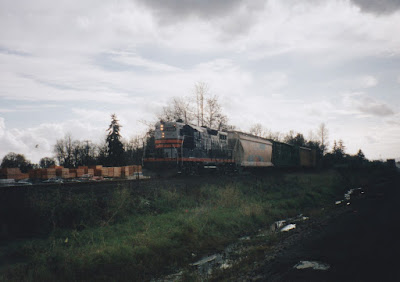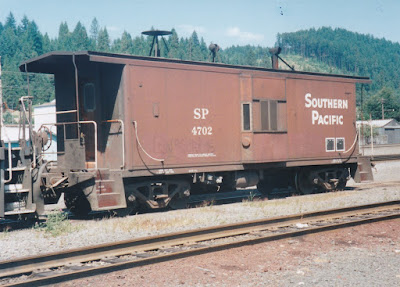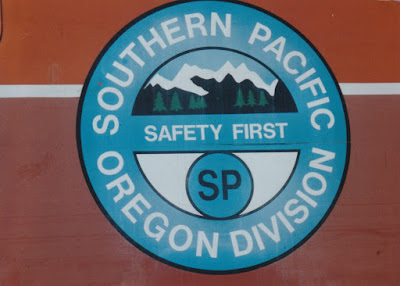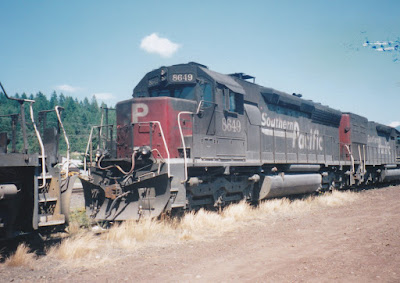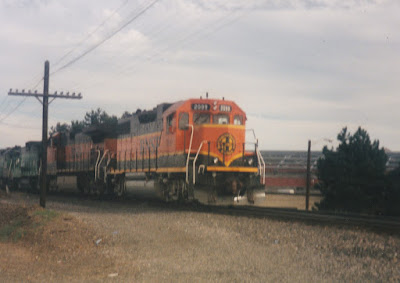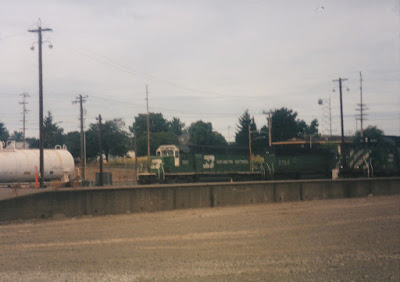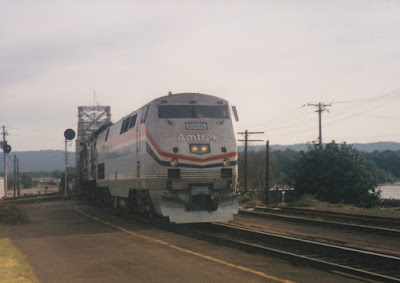On July 13, 1997, my dad and I were railfanning with his friend Fred Anderson. We had been to Vancouver, Washington, earlier in the day before going to Portland, Oregon, but we ended up returning to Vancouver on our way home. Heading back to Vancouver's
Amtrak station, we passed under the Sixth Street Viaduct just as the locomotives of a westbound
Burlington Northern Santa Fe freight train were passing over it. I alone noticed that one of the locomotives was an EMD unit that was painted in the new orange and green paint scheme. At the time, the only locomotives we knew about in that scheme were the new GE Dash 9-44CWs. My dad didn't believe me, but we stopped to look anyway, and I was proven right.
The freight train had come to a stop, and the lead locomotive was indeed an EMD unit in the BNSF orange and green paint scheme.
This was Burlington Northern Santa Fe #2099, which was the first older locomotive to be repainted into this paint scheme.
BNSF #2099 is a 2,000-horsepower GP38-2 that was built by the Electro-Motive Division of General Motors in November 1974 as Burlington Northern #2099.
The locomotive was painted by Mid-America Car, Inc. in Kansas City, Missouri, in September 1996, and was still clean and shiny. BNSF might have been taking special care of it, as it was testing the Positive Train Separation satellite tracking system in the Pacific Northwest.
The second locomotive in the train's long consist was Burlington Northern Santa Fe #1021, a 4,400-horsepower Dash 9-44CW that was built by General Electric in October 1996. It clearly wasn't receiving the attention that BNSF #2099 was.
I took the opportunity to take as many pictures as I could of this unique locomotive.
Like the new Dash 9-44CWs, BNSF #2099 featured silver paint on its trucks, fuel tank and air reservoirs. The silver would be replaced by green on future repainted locomotives.
BNSF #2099 and its train were stopped in a position from which it could either turn south toward Portland or north toward Seattle.
We weren't sure how long BNSF #2099 would be waiting here, or which direction it would go when it resumed its journey. We waited at the Amtrak depot to find out.
It turned out that BNSF #2099 wasn't the only locomotive in Vancouver with an unusual paint scheme that day. Parked in the engine terminal was Burlington Northern #7812, a 3,000-horsepower SD40-2 that was built by the Electro-Motive Division of General Motors in June 1977 as Colorado & Southern #942. Colorado & Southern was a subsidiary of Burlington Northern, and its locomotives were painted in Burlington Northern colors, but they had their own numbering system. These locomotives began to be renumbered into the Burlington Northern's main numbering system in December 1978, and this locomotive became Burlington Northern #7812.
Oddly, Burlington Northern #7812 wore the "billboard" lettering usually found on BN GP50s. It turns out that this locomotive was involved in an accident along with a BN GP50. Both were repaired and repainted by a contract shop, which painted them both with the GP50-style lettering.
Another westbound BNSF freight train came along bound for Portland. It was led by BNSF #1050, a 4,400-horsepower Dash 9-44CW that was built by General Electric in November 1996.
The trailing unit in this train's locomotive consist was
Norfolk Southern #3183 a 3,000-horsepower SD40 that was built by the Electro-Motive Division of General Motors in April 1971 as Southern Railway #3183. This locomotive technically wears the GSF reporting marks of the NS subsidiary Georgia & Southern Florida Railway.
A southbound Union Pacific freight train passed through, led by
Union Pacific #9457, a 4,135-horsepower Dash 8-41CW that was built by General Electric in October 1991 as a Dash 8-40CW. It was redesignated as a Dash 8-41CW in September 1993.
The next train to arrive was Amtrak's northbound Coast Starlight.
The Coast Starlight was led by Amtrak #808, a 4,000-horsepower Dash 8-40BP (or B40-8P) that was built by General Electric in 1993.
Following the Coast Starlight was a northbound Union Pacific freight train, led by Union Pacific #9736 is a 4,380-horsepower Dash 9-44CW that was built by General Electric in August 1994.
We saw BNSF #2099 get underway and head north, so we got into the car and hurried to the grade crossing at 39th Street.
This was a great opportunity for more pictures of this unique unit as is slowly passed by with its freight train.
Even some relatively close-up detail pictures were possible.
The low afternoon sun really lit up the orange paint and yellow striping.
While we waited for BNSF #2099's northbound train to clear the crossing, a southbound freight train came along, led by Burlington Northern #2889, a GP39M that was originally built by the Electro-Motive Division of General Motors in February 1964 as Southern Pacific GP35 #6551. It was retired by Southern Pacific on November 15, 1990, and sold to Morrison-Knudsen on April 1, 1991, where it was rebuilt as BN GP39M #2889 and completed on August 20, 1991.
After the freight trains cleared the 39th Street grade crossing, we raced to Kalama, Washington, for another chance to photograph BNSF #2099. While we waited on the Oak Street Overpass, a southbound BNSF freight train came through, led by a Burlington Northern SD40-2, whose number I can't make out due to the speed of the train and the low light.
BNSF #2099 arrived with its northbound freight train, speeding through Kalama.
The train was going so fast that in this picture, only the front of the locomotive is in focus.
Between the setting sun and the fact that we were almost home, we gave up the chase here.

